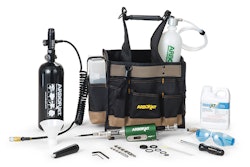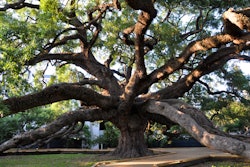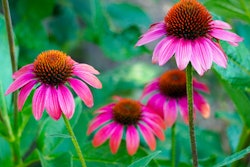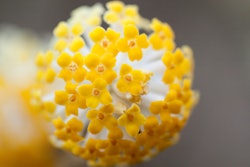Winter annual weeds germinate during the fall then rear their ugly heads in the winter and early spring until they go to seed and die back as a result of summer temperatures. These weeds make turf look unkempt with their varied color and texture and compromise the quality of the turf. They compete with turf for space, nutrients and water. If you don’t get these weeds under control, they can delay green-up of warm-season turfgrasses in the spring.
Winter weeds include grassy weeds, such as annual bluegrass (Poa annua), little barley, rescuegrass, downy brome and cheat, and broadleaf weeds such as henbit, chickweed and dwarf fleabane. While these are some of the major offenders, there are more, and it’s critical to correctly identify which weed you’re dealing with. Without that piece of information, you won’t be able to select an herbicide to treat it. If you need assistance, consult your county extension agent or go online – many university extension services post pictures on their Web sites to help you identify the weed in question.
Before and after
Winter weeds can be controlled pre-emergently or post-emergently. Pre-emergence herbicides affect germinating seeds, so apply them two to three weeks before the seeds germinate. For much of the country, this germination takes place in late September and October. Keep in mind pre-emergents don’t discriminate between weed and grass seeds, so you’ll need to schedule any overseeding far enough in advance to allow grass seeds to sprout and harden off before applying pre-emergents.
Post-emergents are designed to combat weeds that are up and growing. They typically are formulated to be absorbed by the weeds’ leaves, so liquid forms of treatment tend to yield better results than granular herbicides. These you’ll want to apply soon after weeds emerge (typically October or November). If you miss this window, the next best time to apply them is late winter/early spring, but you’ll have to increase the rate of application to kill mature weeds.
Pre- and post-emergents are suitable for both grassy and broadleaf weeds. However, for grassy weeds, a pre-emergent is going to be the most effective. When selecting a herbicide consider the weed you are trying to control, how safe the product is on your specific type of turfgrass, its soil longevity, and of course cost. And certainly read the label. Some post-emergents, for example, are not safe to use on cool-season turfs. They will kill the turf along with the weeds.
Some of the most common pre-emergence herbicides for winter weeds are prodiamine, pendimethalin, benefin (Balan), and dithiopyr. Most of these are relatively safe on a number of established turfs, including Bermudagrass, and should be watered into the root zone upon application.
Post-emergence herbicides that selectively control most broadleaf winter weeds in turf include 2,4-D, MCPP (mecoprop), dicamba (Banvel) and diquat. Many products are a combination of these active ingredients, and are safe to use on established turfs, including Bermudagrass, perennial ryegrass, tall fescue, Kentucky bluegrass and zoysiagrass. Dicamba is often added to help knock out tough weeds, but use it carefully. It is mobile in soil and can injure ornamentals if used within their drip line.
There are also herbicides that can have both pre- and post-emergence control for winter weeds: pronamide (Kerb), simazine (Princep) and atrazine. Never apply pronamide on Kentucky bluegrass, perennial ryegrass or tall fescue.
Many times, cultural practices alone will be sufficient for ridding weeds or significantly reducing their number: adjusting mowing height and frequency, modifying irrigation rate and timing, evaluating fertilizer composition and rate, and relieving compacted soil.











